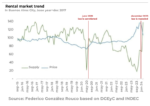You probably haven’t even noticed the Great Chocolate Crisis of 2024, but it is real and some of us are very concerned! The wholesale price of cocoa, which comes from the cocoa bean, is the main ingredient in chocolate and has skyrocketed in price!
When the Spanish Conquistadors came across cocoa 500 years ago it was use by the Aztecs of Mexico in a drink combined with hot peppers—Talk about “hot coco!” It was called "the food of the gods." On the Thornton Necessity Index, it comes in third place behind Electricity and Gasoline. Americans on average consume it every day, or at least wished they did.
Twenty years ago, the price of cocoa was about $1,500/metric ton. Wholesale cocoa is traded in the “futures market” where chocolate makers contract with cocoa suppliers for trades in the near future. It is sold in 10-ton chunks. That makes a lot of candy bars!
Ever since the Housing Bubble inflation the price has risen and stayed within a range around the $2500 level. It broke the all-time high of $3,600 around this time last year and has been skyrocketing ever since. Lately the price has been over $11,000 per ton!!!
How could this happen and what does it mean for the price of my candy bars? Is it speculators, the Federal Reserve, or just normal supply and demand factors?
Well, it is all of that!
Monetary inflation from the Federal Reserve has raised prices across the board. Gold is at an all-time high! However, the Fed’s inflation has masked over the fact that in the prior 40 years before this crisis, the inflation-adjusted market price of cocoa--like most commodities--has actually declined by over 65 percent!
The journalistic accounts of this crisis push the “climate change” agenda so it’s being intentionally manipulated by the media. As usual the climate change explanation would be hard pressed to explain crop production that is highly concentrated in small areas, such as western Africa.
The major decrease in supply is indeed partly due to weather in a small area in western Africa which is the world’s leading supplier and is experiencing different weather that harms crop production. However, this area experiences periodic weather changes related to El Nino and La Nina like weather patterns that are currently impacting crop production in that area. Those patterns should soon reverse, and other growing areas may benefit from those same weather patterns. In contrast to the chicken little climate change hysterics, the sky is not falling in on the chocolate market!
Higher cocoa prices have translated into high chocolate prices over the last year, as expected, and higher chocolate prices have already translated into declining sales for chocolate products. Producers and consumers have responded predicably to the “crisis.”
If it is indeed a crisis of a longer-term variety, the market is already prepared. The supply of cocoa and chocolate takes a long time to adjust due to the nature of growing, harvesting, and producing the products. As a result, speculators have entered the market and driven the raw material price much higher and taken part of the supply and put it into “speculative inventory.” This has the chocolate markers responding too.
Some of the speculators have already made a great deal of money, but if the crisis subsides and the longer-term crisis fails to emerge, many could lose substantial investment dollars.
Nevertheless, I would imagine that other investors are investing in long term projects to grow cocoa both inside and outside of the area impacted by this weather pattern. Afterall, chocolate is a good source of caffeine, magnesium, and is rich in theobromine and phytonutrients which address a large variety of health problems, so there should be strong demand for the crop in the future.
So, take solace chocolate lovers, while higher prices caused by the Federal Reserve are probably here to stay, the market is doing what it can to make sure that everyone continues to have access to Reese’s cups, even if they contain a few more peanuts and a little less chocolate while adjusting to these changing market conditions.
Full story here Are you the author? Previous post See more for Next postTags: Featured,newsletter






















